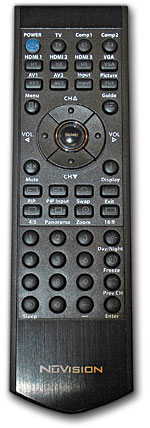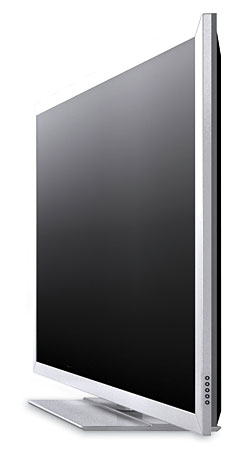NuVision Lucidium NVU55FX10LS 3D LCD HDTV Page 2
 The remote is a good one with backlighting and direct input selection buttons. The backlighting only illuminates the icons on the buttons themselves, not the lettering next to each button that more clearly describes its function. That 1:1 aspect ratio doesn’t have its own button; to engage it, you must push Enter, then 3.
The remote is a good one with backlighting and direct input selection buttons. The backlighting only illuminates the icons on the buttons themselves, not the lettering next to each button that more clearly describes its function. That 1:1 aspect ratio doesn’t have its own button; to engage it, you must push Enter, then 3.
Video Processing
The NuVision sailed through most of our standard video processing tests, with the notable exception of 2:2 pulldown (in both HD and SD). Failure of this test has been fairly common among the sets we’ve tested.
With some types of sources, the NVU55FX10LS will not pass the Video Clipping test—that is, it will not reproduce any above-white or below-black information present in the program material. For the techies in the gallery, that means it clips all material below a video level of 16 and above a video level of 235 with those sources. For more details and an explanation of why the NuVision received a passing grade on this test, see HT Labs Measures. In theory, the lack of above-white and below-black information will only rarely have an obvious effect on the picture. But this clipping can make it harder to properly adjust the video settings. The lack of above-white headroom can also crush details in scenes that sometimes exceed the normal peak-white level, such as brightly sunlit clouds.
2D Performance
Although the NuVision has some minor technical issues in its color performance, it produces highly pleasing images on program material of average brightness. While its color doesn’t jump out at you as it does on some sets, the NVU55FX10LS’ color looks refined and natural with reasonably neutral program material. For example, the color balance in the HD broadcast of the 2011 Golden Globes was spot on, with nearly ideal fleshtones. So was the color in the innumerable college and pro football playoff games that flooded my cable channels last December and January (as I write this, the latter are still going on, with Stupor Sunday yet to come).
I recently acquired season five of The Universe on Blu-ray. The HD video images of the cosmos in that production (most of them computer generated, of course) were truly remarkable on the NuVision. The colors were striking, and the set’s superb resolution rendered fine details beautifully.

The resolution was so good, I could easily spot variations in focus from shot to shot, particularly in HD broadcasts. In HD, the wear and tear of the passing years on television performers is visible in a way it never was in the olden days of SD. A little soft focus here and there can prevent diva distress. As the closeups shifted between House and Cuddy in a recent episode of House, the titular character looked tack sharp, while Cuddy’s image was subtly softened each time the shot shifted back to her. This could have been a setup error during the shoot, but it also could have been… well, you know. The NuVision doesn’t hide the trickery.
Color and resolution presented no problems for the NuVision, but black levels, shadow detail, and uniform screen illumination were different matters. At their best, the set’s black levels were deep and satisfying. But there were a number of interacting issues that limited the NVU55FX10LS’ performance with dark scenes.
 Even the Gamma control’s minimum setting of 2.0 was too dark. The true gamma was much higher than 2.0, as later measurements confirmed (see HT Labs Measures). (Low gamma numbers lighten the mid-brightness region; high numbers darken it.) I got results that were generally pleasing on most sources by carefully juggling the Brightness, Contrast, Gamma, and Backlight controls, sometimes in ways that varied from their most technically precise levels. But on material that has many genuinely dark, low-contrast scenes—for example, Harry Potter and the Half-Blood Prince and Unbreakable—no combination of settings produced a fully satisfying balance of black level and shadow detail.
Even the Gamma control’s minimum setting of 2.0 was too dark. The true gamma was much higher than 2.0, as later measurements confirmed (see HT Labs Measures). (Low gamma numbers lighten the mid-brightness region; high numbers darken it.) I got results that were generally pleasing on most sources by carefully juggling the Brightness, Contrast, Gamma, and Backlight controls, sometimes in ways that varied from their most technically precise levels. But on material that has many genuinely dark, low-contrast scenes—for example, Harry Potter and the Half-Blood Prince and Unbreakable—no combination of settings produced a fully satisfying balance of black level and shadow detail.
The sides and bottom of the NuVision’s picture were also slightly brighter than the center. You won’t notice this on most material, but it becomes painfully obvious in very dim scenes, particularly in a darkened room. All of the edge-lit LED sets we’ve seen have had this problem, whether their edge lighting is dynamic or fixed. It’s particularly rampant in very thin sets such as this one. The thinner the set, the more difficult it is to diffuse the LED edge-lighting uniformly across the screen. In dark scenes, the affected areas look grayer than they should, as if there were a street lamp or some other light source sitting off-screen. The NuVision also had a slightly darkened horizontal band about a third of the way up from the bottom of the screen. It was most visible when the affected area was a consistent field of gray or a uniform area of color. This was largely invisible in bright scenes.
The True Dimming feature also pumped noticeably when the program material shifted rapidly between scenes that differed significantly in their average brightness levels. On most material, I only saw this artifact occasionally, but when it did turn up, there was no mistaking it. I turned True Dimming off, which cured the pumping problem, but it also seriously degraded the black level. Without True Dimming, the uneven illumination at the edges of the picture was even more obvious.













































